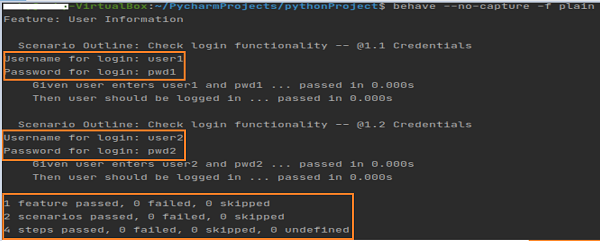
- Behave Tutorial
- Behave - Home
- Behave - Introduction
- Behave - Installation
- Behave - Command Line
- Behave - Configuration Files
- Behave - Feature Testing Setup
- Behave - Gherkin Keywords
- Behave - Feature Files
- Behave - Step Implementations
- Behave - First Steps
- Behave - Supported Languages
- Behave - Step Parameters
- Behave - Scenario Outlines
- Behave - Multiline Text
- Behave - Setup Table
- Behave - Steps in a Step
- Behave - Background
- Behave - Data Types
- Behave - Tags
- Behave - Enumeration
- Behave - Step Matchers
- Behave - Regular Expressions
- Behave - Optional Part
- Behave - Multi-Methods
- Behave - Step Functions
- Behave - Step Parameters
- Behave - Runner Script
- Behave - Exclude Tests
- Behave - Retry Mechanism
- Behave - Reports
- Behave - Hooks
- Behave - Debugging
- Behave Useful Resources
- Behave - Quick Guide
- Behave - Useful Resources
- Behave - Discussion
Behave - Scenario Outlines
A Scenario Outline is used if we have a group of similar criteria and the results are to be passed in a Scenario. A Scenario Outline is accompanied with an Examples table. A Scenario Outline can have multiple Examples tables.
The tests get executed once for every row found (after the header row) within the Examples table. The values to be tested are represented by their names enclosed in brackets<>. These names should match with the Examples table header.
It helps to reduce the lines of code (eliminates repeating steps) and orders our tests.
Feature File
The feature file for scenario outline is as follows −
Feature − User information
Scenario Outline: Check login functionality
Given user enters "<name>" and "<password>"
Then user should be logged in
Examples: Credentials
| name | password |
| user1 | pwd1 |
| user2 | pwd2 |
Please Note: We have kept the name and password parameters enclosed in "<>". These parameters are column headers provided below the Examples section. In the step implementation, we shall pass the parameters enclosed in "{}".
Also, these parameters need to be passed as arguments to the implementation method.
Corresponding Step Implementation File
The corresponding step implementation file is as follows −
from behave import *
@given('user enters "{name}" and "{password}"')
def step_implpy(context, name, password):
print("Username for login: {}".format(name))
print("Password for login: {}".format(password))
@then('user should be logged in')
def step_implpy(context):
pass
Output
The output is obtained after running the feature file and the command used is behave --no-capture -f plain.

The output shows Username for login: user1, Password for login: pwd1 and Username for login: user2, Password for login: pwd2 printed. Here, the two data sets were passed from the Examples.